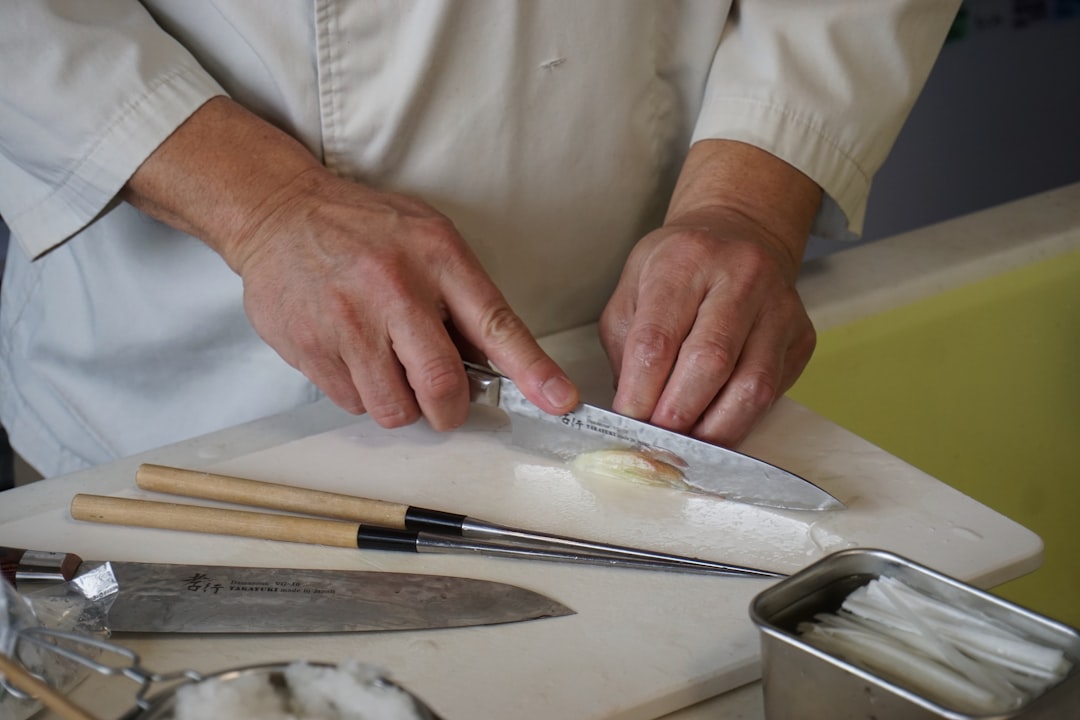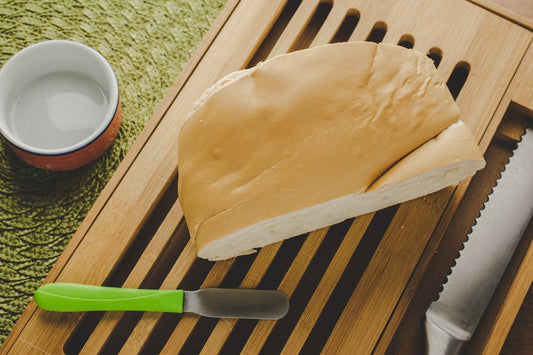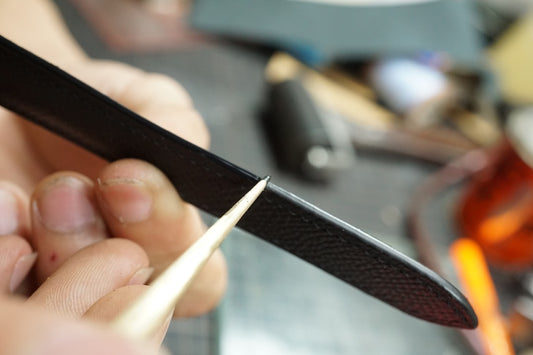
Share
What is Damascus Patterning? An In-Depth Guide to Traditional Japanese Knife Forging
Estimated Reading Time: 12 minutes
Key Takeaways
- Understanding the artistry and tradition behind Japanese knife forging.
- Exploring the significance of Damascus patterning in knife making.
- Comparing different knife constructions: Sanmai, Kasumi, and Honyaki.
- The role of traditional Japanese blacksmiths in preserving cultural heritage.
Table of Contents
- The Tradition of Japanese Knife Forging: Traditional Japanese Blacksmiths
- What is Damascus Patterning? Origin and Craft of Damascus Patterned Steel
- The Japanese Knife Forging Process: Craftsmanship from Start to Finish
- Sanmai vs Kasumi Construction: Comparing Knife Construction Methods
- Honyaki Japanese Knives Explained: Mastery of Monosteel
- The Role of Traditional Japanese Blacksmiths Today: Guardians of Craft and Legacy
- Conclusion: Honoring the Legacy of Japanese Knife Forging
The Tradition of Japanese Knife Forging: Traditional Japanese Blacksmiths
For hundreds of years, traditional Japanese blacksmiths, known as sakai or tanzo, have been shaping steel into some of the world’s finest blades. The history of Japanese knife making stretches back to the sword-smithing traditions of ancient Japan, with skills and secrets passed down directly from master to apprentice. These craftspeople are respected not just for their skill, but because they are keepers of a living cultural legacy. Japanese Knife Forging Process
The Foundations of Japanese Blacksmithing
Japanese bladesmithing is deeply woven into Japan’s cultural fabric. Each blacksmith is more than a craftsman—they're an artist, engineer, and guardian of tradition. The Japanese knife forging process preserves old methods while continuing to adapt to the evolving needs of modern cuisine.
- Mastery of Materials: Blacksmiths must understand the subtle differences between various metals, particularly the combination of hard and soft steels.
- Art Meets Science: Every process—from heating to quenching—demands both scientific precision and an intuitive feel for timing, temperature, and transformation.
- Dedication to Quality: Each blade is crafted to be razor sharp, well-balanced, and elegant, fulfilling both aesthetic and functional needs.
The relentless pursuit of perfection, respect for materials, and a commitment to harmony are what set traditional Japanese blacksmiths apart. Their artistry means that every finished knife is both a tool and a symbol of Japanese heritage.
What is Damascus Patterning? Origin and Craft of Damascus Patterned Steel
Damascus patterning is one of the most visually striking features seen on high-quality knives today. But what is Damascus patterning in the context of traditional Japanese blades, and why does it matter?
Definition and Historical Background
Damascus patterning refers to the swirling, wave-like lines that appear on the blade’s surface. These patterns are not simply decorative—they are born from sophisticated metalworking processes. Originally, Damascus steel was forged in the Middle East, renowned for its strength, resilience, and the beautiful patterns produced by its layered structure.
Through the ages, Japanese blacksmiths adapted and refined the concept. Today, the Damascus pattern seen on Japanese knives stands as a testament to a fusion of Eastern and Western forging traditions, now elevated into a uniquely Japanese art form. The aesthetic appeal is matched by functional benefits, earning Damascus patterned knives widespread admiration from both chefs and collectors.
How Damascus Patterns Are Created in Steel
The process starts by stacking and forging together multiple layers of different types of steel, typically alternating layers of high-carbon and softer iron. The metals are heated to high temperatures, hammered flat, and then folded back onto themselves repeatedly. Each fold doubles the number of layers, creating thousands of microscopic layers over time.
The Steps Include:
- Layering and Stacking: Alternating steels are stacked together.
- Heating: The stack is heated in a forge until the metals are nearly molten.
- Folding: The metals are hammered, elongated, and folded back repeatedly.
- Welding: Each fold is forged into a single, unified billet.
- Shaping: The forged metal is then shaped into a blade, revealing the beautiful internal patterns as it’s ground and polished.
This process creates the characteristic swirling, wavy, and flowing patterns associated with Damascus steel. No two blades are alike—every knife boasts a unique visual motif, a literal fingerprint of its creator.
Beauty, Functionality, and Benefit
- Aesthetics: The layered, marbled appearance is visually stunning and instantly recognizable.
- Strength and Stability: The folding process helps to distribute hardness and flexibility, resulting in a tough yet resilient blade.
- Reduced Impurities: Folding and layering drive out imperfections, producing cleaner, more refined steel.
- Performance: The final blade achieves excellent edge retention and cutting precision.
In short, Damascus patterning is both an artistic and engineering achievement—combining beauty, strength, and high performance into one exceptional blade.
FAQ
What is the significance of Damascus patterning in Japanese knives?
Damascus patterning not only enhances the aesthetic appeal of Japanese knives but also contributes to their strength and performance. The intricate patterns are a result of folding and layering different steels, which improves the blade's durability and cutting precision.
How do Sanmai and Kasumi knife constructions differ?
Sanmai knives have a hard steel core sandwiched between two softer outer layers, offering durability and flexibility. Kasumi knives feature a soft iron jacket with a hard steel edge, making them easier to sharpen and ideal for precision cutting.
Why are Honyaki knives considered the pinnacle of Japanese knife forging?
Honyaki knives are crafted from a single piece of high-carbon steel without any layering. The forging process requires exceptional skill, and the knives offer superior edge retention and cutting performance, making them highly valued by professional chefs.
Conclusion: Honoring the Legacy of Japanese Knife Forging
Traditional Japanese knife forging is a rare blend of art, science, and cultural devotion. The journey from glowing steel to finished blade—guided by the hands of masters—is a ritual that preserves centuries-old knowledge and produces culinary tools unlike any other.
Let’s recap the key insights:
- Traditional Japanese blacksmiths and their apprentices are the cornerstone of this living tradition, carrying forward hard-earned skills and techniques.
- The answer to "what is Damascus patterning" lies in its fusion of beauty, strength, and function: restful, swirling motifs born from folding and layering steel, admired worldwide.
- The Japanese knife forging process is meticulous, blending special forging, heat treatment, and hand finishing steps to deliver knives with unmatched quality.
- Sanmai vs Kasumi construction illuminates the different ways Japanese bladesmiths balance sharpness, flexibility, and ease of sharpening for various culinary needs.
- Honyaki Japanese knives stand as the highest benchmark of bladesmithing, demanding supreme skill and offering professional chefs ultimate performance.
Above all, the continued work of traditional Japanese blacksmiths ensures that these priceless crafts are preserved for future generations. By appreciating the care, wisdom, and artistry infused into every knife, we help sustain a cultural legacy that enriches kitchens and inspires wonder around the globe.
The next time you pick up a traditional Japanese knife—or simply admire one—take a moment to reflect on the centuries of knowledge and dedication embodied in that blade. Whether you’re a budding chef, an enthusiast, or an admirer of precise craftsmanship, understanding these traditions deepens your respect for the art and for those who keep it alive.


